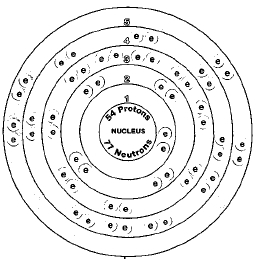
If you were to study the basics of the periodic table, you would would find out rather quickly that Dmitri Mendeleev created a pretty incredible table. I mean, there have been other notable inventions or creations such as the lightbulb, the internet, pizza and the movie Back to the Future, but I would say that the periodic table changed the world without most people knowing it. As you begin to notice all the arranged patterns and numbers in the table, it begins to morph into more than just a table of information. It turns into a picture and representation of many topics ranging from electronegativity to atomic radius, which are essentials for basics in chemistry. But alas, the only reason I'm even mentioning the periodic table is because I started to make connections between the elemental properties and those people who surround you on a daily basis. I was chuckling quite loudly in the library when I was wasting some time coming up with people who I could link to these property groups (obviously my spare time is spent doing important stuff). I wouldn't have been able to finish it if it weren't for the magnificently helpful periodic table.
First up are the alkali metals which can be found in group I. These are strongly reactive metals that commonly make salts when reacted with the halogens. The alkali metals are like those people who want to desperately create relationships, whether they are just friendly relationships or romantic ones. They are willing to give up things (electrons) to the other person in order to create this relationship. Who are these other persons? These are the hoarders also known as the halogens filling up group IIVA. Halogens really only care about themselves, always looking for electrons to take from other elements. When chloride (let's says Bob) becomes friends with potassium (let's say Emma), it's only because Emma has more money and is willing to share it with Bob who is willing to start this friendship because he's looking for electrons, err, money. As you can see, it's not a very fruitful relationship, but hey, how else could we get table salt, NaCl?
The alkaline earth metals are kind of goofy because they are not really found free in nature, which begs the question: why call them earth metals? Well that's because they can be found within Earth's crust, although not in their elemental form. For example, magnesium can be found in carnellite and dolomite. Being that they are harder and denser than the alkali earth metals, you would assume that they have a stronger character and less willing to give up things to be in a relationship. Even though I just completely made up that connection, you would actually be right in assuming that. Although these are also quite reactive, they are not as reactive as their neighbors from group I. In other words, in this case Emma would maybe not give Bob her money, but she might give it to Steven instead (oxygen mostly). Why Steven? I don't know. Maybe because he's a little nicer, better looking, or maybe even both? Emma still has some issues to resolve however.
The transition metals are what I would call the average people. They are pretty down to earth. They are willing to create relationships or not. They are good conductors of friendships and energy. They can be very colorful (CuSO4 5H2O) and jubilant. The metalloids are the half metals. You know, like those people who are just unsure of themselves (who isn't right?), the metalloids are kind of metals but not really. Then there are the non-metals. These do not conduct electricity or heat very well. In other words, these are perhaps the unfriendly people. The ones who greet you with a funky face when you say 'Good morning.' They do not reflect light. A tad bit similar to these are the other metals. Yes, that is what they are really called. They are described as being opaque, or perhaps in terms of people, boring. However, they include a rather interesting pack, with aluminum and lead being members. So let's call these the boring people who get the job done. There are also the rare earth metals, and well, they're just rare. I don't know much about them and I would assume that is why they call them rare. I suppose these could be either strange people or maybe even people who have special abilities. Special abilities like playing an instrument very well or..... telekinesis à la Carrie style!
Last but certainly not least, are the noble gases. You can imagine who they are, right? These are the pacifists, the wise and the enlightened, if you will. They do not readily take up electrons because their valence shells already have the desired eight (you know, the eight that the halogens are always trying to attain). I suppose that's why they are called the "noble" gases.
So this is what I came up with during my spare time. It's not well thought out, it was just a spur of the moment sort of thing. I'm sure that we could use many other properties and turn the roles around for any of these groups (i.e. maybe the halogens are not really hoarders but instead hard workers because they're always looking for things to get done). But alas, this is what I came up with on a Thursday afternoon in the library so it's pretty simple minded. But the question is, which one are you? The alkali or alkaline earth metals, the halogens or transitional metals, the non metals or the rare metals, or perhaps even a noble gas?
No comments:
Post a Comment